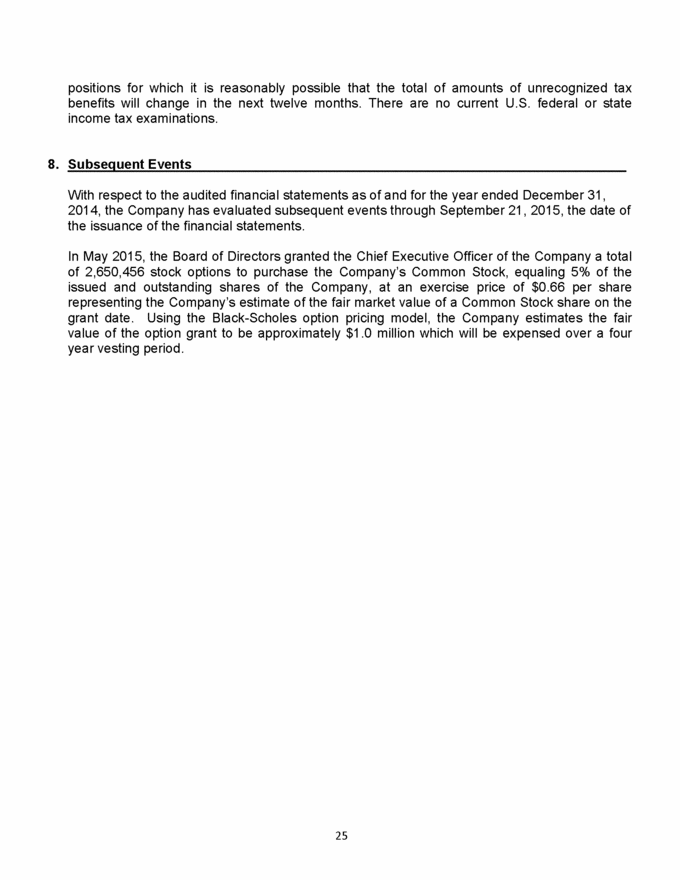Attached files
| file | filename |
|---|---|
| EX-99.4 - EX-99.4 - BIOTELEMETRY, INC. | a17-4064_1ex99d4.htm |
| EX-99.3 - EX-99.3 - BIOTELEMETRY, INC. | a17-4064_1ex99d3.htm |
| EX-99.1 - EX-99.1 - BIOTELEMETRY, INC. | a17-4064_1ex99d1.htm |
| EX-23.2 - EX-23.2 - BIOTELEMETRY, INC. | a17-4064_1ex23d2.htm |
| EX-23.1 - EX-23.1 - BIOTELEMETRY, INC. | a17-4064_1ex23d1.htm |
| 8-K/A - 8-K/A - BIOTELEMETRY, INC. | a17-4064_18ka.htm |
Exhibit 99.2
TELCARE, INC. AND CONSOLIDATED SUBSIDIARY FINANCIAL STATEMENTS AS OF DECEMBER 31, 2014 AND 2013 AND FOR THE YEARS ENDED DECEMBER 31, 2014 AND 2013 2014
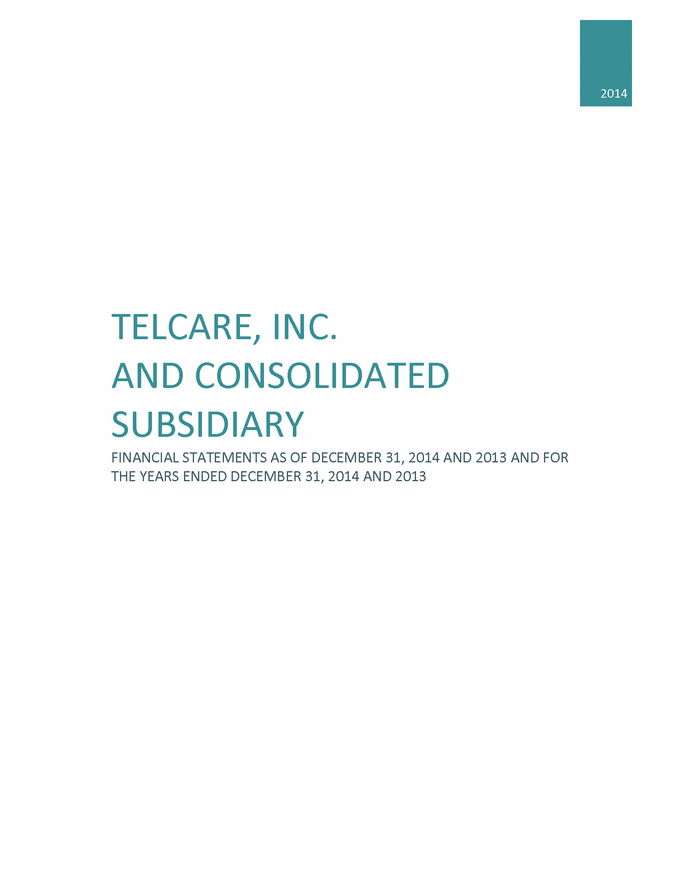
TABLE OF CONTENTS INDEPENDENT AUDITOR’S REPORT………………………………………………………. DECEMBER 31, 2014 AND 2013 FINANCIAL STATEMENTS Consolidated Balance Sheets……………………………………………………….…...... Consolidated Statement of Operations…………………………………………………… Consolidated Statement of Cash Flows…………………………………….……….….... Consolidated Statement of Changes in Stockholders’ Equity and Retained Deficit…. Notes to Consolidated Financial Statements............................................................... 1 2 3 4 5 6-25
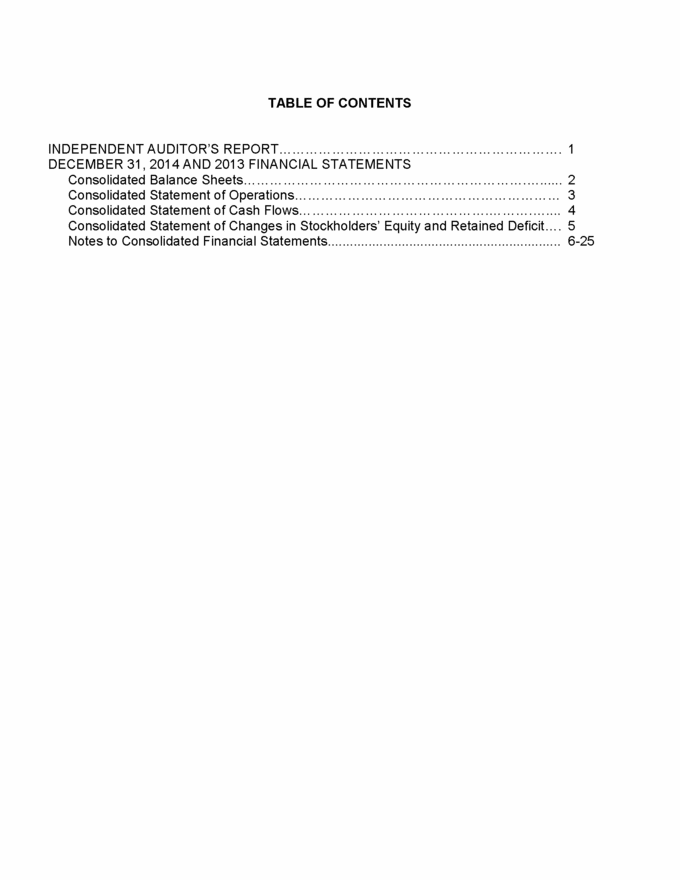

Report of Independent Auditors
To Board of Directors and Management of
Telcare, Inc.
We have audited the accompanying consolidated financial statements of Telcare, Inc. and its subsidiary, which comprise the consolidated balance sheet as of December 31, 2014, and the related consolidated statement of operations, of stockholders’ equity and retained deficit and of cash flows for the year then ended.
Management’s Responsibility for the Consolidated Financial Statements
Management is responsible for the preparation and fair presentation of the consolidated financial statements in accordance with accounting principles generally accepted in the United States of America; this includes the design, implementation, and maintenance of internal control relevant to the preparation and fair presentation of consolidated financial statements that are free from material misstatement, whether due to fraud or error.
Auditors’ Responsibility
Our responsibility is to express an opinion on the consolidated financial statements based on our audit. We conducted our audit in accordance with auditing standards generally accepted in the United States of America. Those standards require that we plan and perform the audit to obtain reasonable assurance about whether the consolidated financial statements are free from material misstatement.
An audit involves performing procedures to obtain audit evidence about the amounts and disclosures in the consolidated financial statements. The procedures selected depend on our judgment, including the assessment of the risks of material misstatement of the consolidated financial statements, whether due to fraud or error. In making those risk assessments, we consider internal control relevant to the Company’s preparation and fair presentation of the consolidated financial statements in order to design audit procedures that are appropriate in the circumstances, but not for the purpose of expressing an opinion on the effectiveness of the Company’s internal control. Accordingly, we express no such opinion. An audit also includes evaluating the appropriateness of accounting policies used and the reasonableness of significant accounting estimates made by management, as well as evaluating the overall presentation of the consolidated financial statements. We believe that the audit evidence we have obtained is sufficient and appropriate to provide a basis for our audit opinion.
Opinion
In our opinion, the consolidated financial statements referred to above present fairly, in all material respects, the financial position of Telcare, Inc. and its subsidiary as of December 31, 2014, and the results of their operations and their cash flows for the year then ended in accordance with accounting principles generally accepted in the United States of America.
|
/s/ PricewaterhouseCoopers LLP |
|
|
|
|
|
|
|
|
Baltimore, MD |
|
|
September 21, 2015 |
|
PricewaterhouseCoopers LLP, 100 E. Pratt Street, Suite 1900, Baltimore, MD 21202
T: (410) 783-7600, F: (410) 783-7680, www.pwc.com
Telcare, Inc. Consolidated Balance Sheet As of December 31, 2014 2013 Assets Current Assets Cash Restricted cash Accounts receivable, net Inventory, net Prepaid expenses Total Current Assets Property and Equipment, net Other Assets $ 20,220,852 $ 4,511,796 1,903,800 565,345 1,422,778 307,436 - 1,737,681 2,832,525 255,831 24,420,211 9,337,833 119,433 204,664 249,653 302,864 Total Assets Liabilities and Stockholders' Equity Current Liabilities Accounts payable and accrued liabilities Deferred revenue Customer deposit payable Warrant liability Accrued compensation and related expenses Convertible notes payable Notes payable, current portion Total Current Liabilities $ 24,789,297 $ 9,845,361 $ 2,696,580 340,632 1,903,800 669,576 490,793 - 1,666,667 $ 1,855,738 549,825 - 707,303 334,580 3,750,000 1,764,667 7,768,048 8,962,113 Long Term Liabilities Long-term debt, net of current portion and debt discount Maryland commercialization grant Total Long Term Liabilities 1,619,461 250,000 3,278,920 250,000 1,869,461 3,528,920 Total Liabilities 9,637,509 12,491,033 Convertible Mandatorily Redeemable Series B Preferred Stock, $0.001 par value, 9,133,603 shares authorized; 8,775,270 issued and outstanding at December 31, 2014 and 2013 Convertible Mandatorily Redeemable Series C Preferred Stock, $0.001 par value, 23,491,757 shares authorized; 22,164,448 issued and outstanding at December 31, 2014 25,368,350 25,368,350 34,459,437 - Stockholders' Equity Convertible Series A Preferred Stock, $0.001 par value, 4,027,290 shares authorized; 3,827,290 issued and outstanding at December 31, 2014 and 2013 Common Stock, $0.001 par value, 59,000,000 shares authorized; 8,458,520 and 7,265,824 issued and outstanding at December 31, 2014 and 2013, respectively Additional Paid in Capital Accumulated Deficit Total Stockholders' Equity Total Liabilities and Stockholders' Equity 3,827 3,827 8,459 626,782 (45,315,067) 7,266 123,298 (28,148,413) (44,675,999) (28,014,022) $ 24,789,297 $ 9,845,361 See notes to Consolidated Financial Statements 2
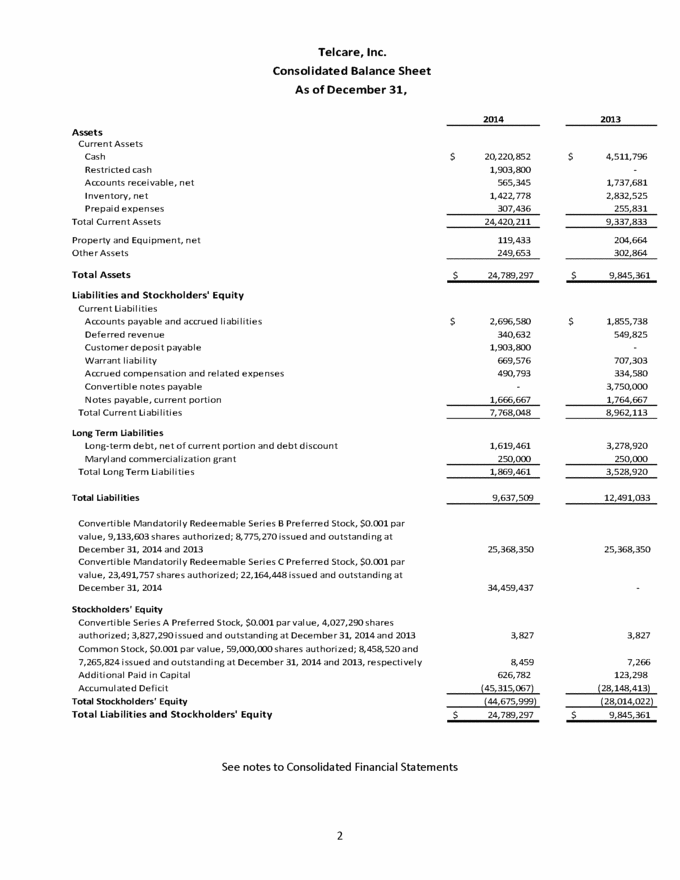
Telcare, Inc. Statement of Operations For the Years Ended December 31, 2014 2013 Revenues $ 4,351,724 $ 6,372,176 Cost of Goods Sold 7,044,684 8,496,301 Gross Profit (2,692,960) (2,124,125) Operating Expenses Marketing and sales Engineering, regulatory and research and development General and administrative 5,553,266 3,320,773 5,049,311 4,863,016 2,797,502 3,127,439 Total Operating Expenses 13,923,350 10,787,957 Loss from Operations (16,616,310) (12,912,082) Other Income Interest Expense Depreciation and Amortization (54,755) 481,493 123,606 (40,877) 200,722 111,390 Net Loss $ (17,166,654) $ (13,183,317) See notes to Consolidated Financial Statements 3
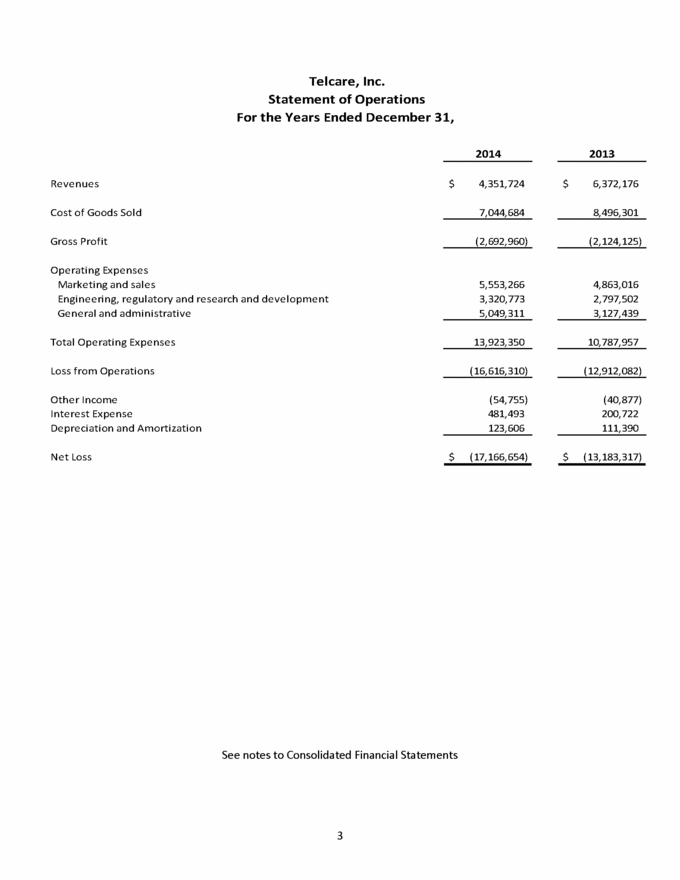
Telcare, Inc. Consolidated Statements of Cash Flows For the years ended December 31, 2014 2013 Cash flow From Operating Activities Net Loss $ (17,166,654) $ (13,183,317) Adjustments to reconcile net loss to net cash used in operating activities Depreciation and Amortization Net Gain on Warrants Stock Based Compensation Issuance of Restricted Stock Accrued Interest on Notes Payable 123,606 (49,572) 154,869 349,808 206,295 111,390 (40,180) 118,302 - - Changes in operating assets and liabilities Restricted Cash Accounts Receivable Inventory Prepaid Expenses Deferred Revenue Customer Deposit Payable Accounts Payable and Accrued Liabilities Warrant Liability Accrued Compensation and Related Expenses Net Cash used in Operating Activities (1,903,800) 1,172,336 1,409,747 1,606 (209,193) 1,903,800 840,843 11,845 156,213 - 225,031 (1,155,972) (352,003) 353,529 - (526,047) 70,297 54,432 (12,998,251) (14,324,538) Cash Flows from Investing Activities Purchases of Property and Equipment Purchase of Investment Net Cash used in Investing Activities (38,376) - (120,048) (100,000) (38,376) (220,048) Cash Flows from Financing Activities Proceeds from Notes Payable Repayment of Notes Payable Promissory Notes Proceeds from sale of Series C Preferred Stock Net Cash Provided from Financing Activities 3,750,000 (1,757,459) - 26,753,142 8,695,587 - 50,000 - 28,745,683 8,745,587 Net Increase (Decrease) in Cash 15,709,057 (5,798,999) Cash, at Beginning of the Period 4,511,796 10,310,795 Cash, at End of the Period $ 20,220,852 $ 4,511,796 Supplemental disclosure of cash flow information Cash Payments during the period for: Interest $ 183,743 $ 180,271 Non-Cash financing activity Conversion of debt into preferred stock Issuance of restricted stock $ $ 7,706,295 349,808 $ $ - - See notes to Consolidated Financial Statements 4
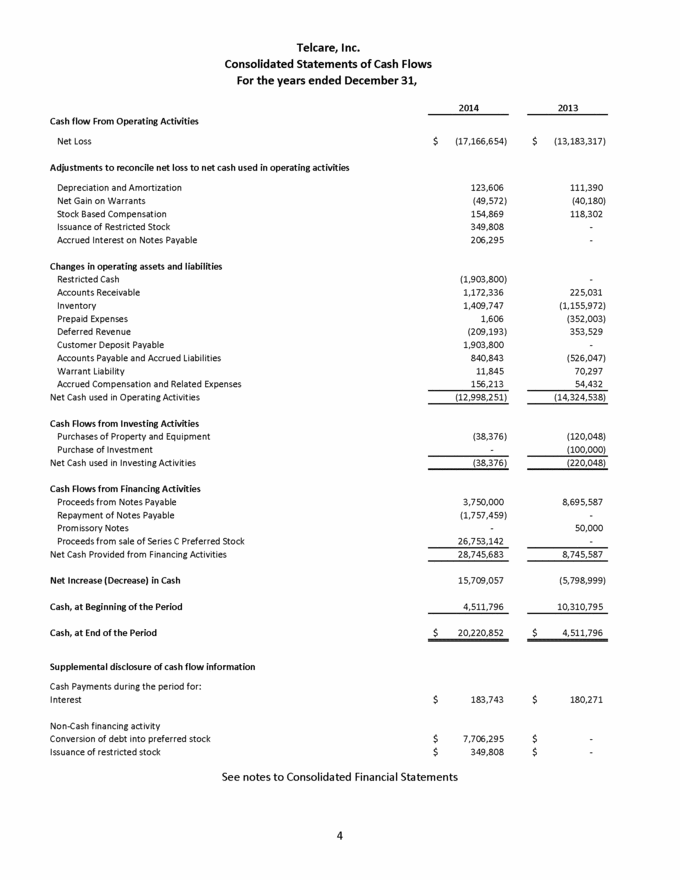
Telcare, Inc. Consolidated Statements of Stockholders' Equity and Retained Deficit Series A Convertible Preferred Stock Common Stock Additional Paid-In Capital Total Stockholders' Deficit Accumulated Deficit Shares Amount Shares Amount Balance at December 31, 2012 3,827,290 $ 3,827 7,265,824 $ 7,266 $ 4,996 $(14,965,096) $(14,949,007) Stock-based compensation expense Net Loss Balance at December 31, 2013 118,302 (13,183,318) 118,302 (13,183,317) 3,827,290 3,827 7,265,824 7,266 123,298 (28,148,413) (28,014,022) Common Stock issued Stock-based compensation expense Net Loss Balance at December 31, 2014 1,192,696 1,193 348,615 154,869 (17,166,654) 349,808 154,869 (17,166,654) 3,827,290 $ 3,827 8,458,520 $ 8,459 $ 626,782 $(45,315,067) $(44,675,999) See notes to Consolidated Financial Statements 5

Telcare, Inc. Notes to Consolidated Financial Statements December 31, 2014 and 2013 1. Organization The Business Telcare, Inc. and its wholly owned subsidiary Telcare Medical Supply, Inc. (the Company) are primarily engaged in the sale of blood glucose meters (BGM), test strips and the accessories associated with the testing of blood by people living with diabetes. The Company sells the first cellular enabled FDA cleared BGM that transmits blood glucose data so that it is available for “real time” review or analysis by the patient, their physician or caregiver. 2. Liquidity The Company has devoted substantially all of our resources since our inception to the development of its products. The Company’s ability to generate revenue and achieve profitability depends largely on its ability, alone or with others, to successfully complete the development of our products, obtain the necessary regulatory approvals and to market and sell its products. The Company’s operations will require significant uses of working capital throughout 2015 and beyond. The Company’s capital requirements will depend on many factors, including the success of its development activities. Based on its current operating plan, the Company believes that the existing cash plus capital raised and committed after December 31, 2014 will be sufficient to meet its anticipated operating needs into 2016. However, the Company may need to raise additional capital sooner and not be able to raise this capital on acceptable terms, or at all. If the Company is unable to secure sufficient capital to fund its development activities, the Company may not be able to continue operations or may have to enter into collaboration agreements that could require the Company to share commercial rights to its products at earlier stages of development or to a greater extent than is currently intended. The accompanying financial statements have been prepared assuming that the Company will continue as a going concern, which contemplates continuity of operations, realization of assets and satisfaction of liabilities in the ordinary course of business. The propriety of using the going-concern basis is dependent upon, among other things, the achievement of future profitable operations, the ability to generate sufficient cash from these operations or from other funding sources, including cash on hand, to meet the Company’s obligations as they become due. The Company believes the going-concern basis is appropriate for the accompanying financial statements based on its current operating plan through September 30, 2016. 6
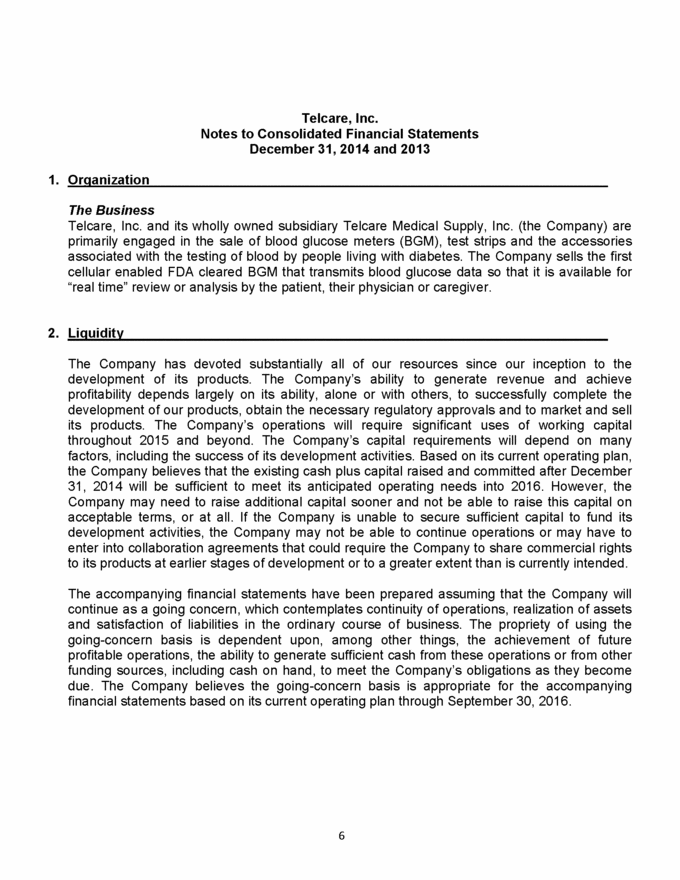
3. Summary of Significant Accounting Policies Principles of Consolidation The Consolidated Financial Statements have been prepared on the accrual basis of accounting and include accounts of Telcare, Inc. and its wholly owned subsidiary Telcare Medical Supply, Inc. All intercompany balances and transactions have been eliminated. Certain Risks and Uncertainties The Company is subject to risks common to companies in the medical device industry, including, but not limited to, development by the Company or its competitors of new technological innovations, dependence on key personnel, reliance on third party manufacturers, protection of proprietary technology, and compliance with regulatory requirements. Use of Estimates The preparation of consolidated financial statements in conformity with generally accepted accounting principles in the United States requires management to make estimates and assumptions that affect the reported amounts of assets, liabilities, revenues and expenses and the disclosure of contingent assets and liabilities in its financial statements. On an ongoing basis, estimates used in these financial statements include the valuation of stock-based compensation expense, inventories, deferred revenue, equity instruments and the lives of fixed assets and intangible assets. The Company may base such estimates on various assumptions which it believes to be reasonable under the circumstances. Actual results could differ from those estimates. Cash and Cash Equivalents For the purposes of financial statement classification, the Company considers all highly liquid investment instruments which are readily convertible into cash with original maturities of 90 days or less, when purchased, to be cash equivalents. There were no items considered to be a cash equivalent at December 31, 2014. Fair Value of Financial Instruments The carrying amounts of the Company’s financial instruments, which include cash and cash equivalents, restricted cash, accounts receivable, convertible notes, accounts payable and accrued expenses, approximate their fair values due to their short maturities. Accounts Receivable and Allowance for Doubtful Accounts Accounts receivable are stated at their net realizable value and consist of amounts due from third-party distributors, third-party payers and patients. Accounts with balances that are deemed uncollectible are written off on an as needed basis throughout the year. Monthly adjustments and write-offs are taken based on amounts generated from the Company’s medical billing system. The Company reviewed its outstanding Accounts Receivable and determined several accounts remained uncollected as of June 30, 2015; accordingly, the Company has recorded an allowance against these amounts (See Footnote 4). 7
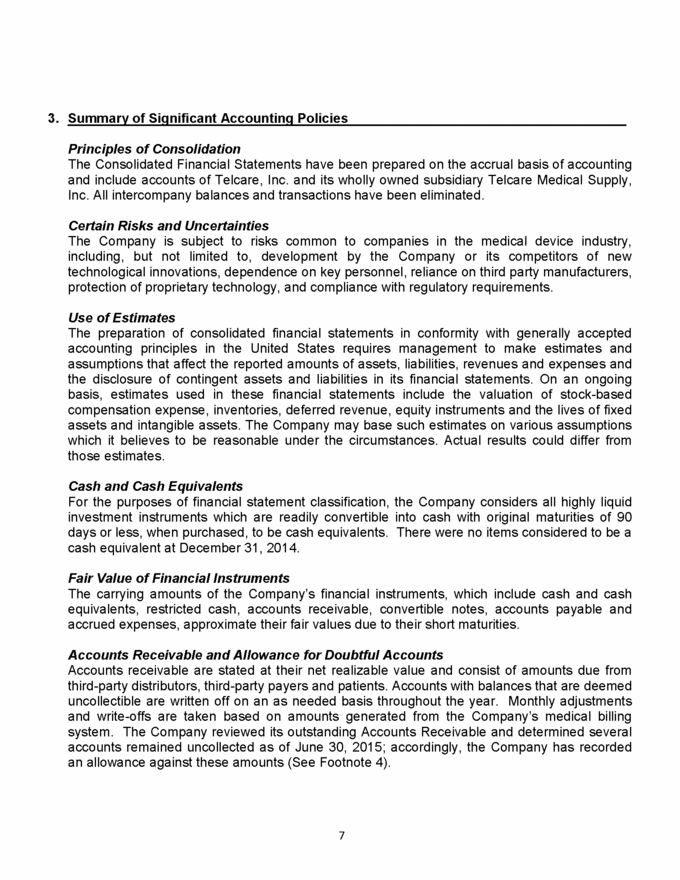
Inventories Inventories are held at the lower of cost or net realizable value, determined using the first-in, first-out method. The Company periodically reviews inventories for slow moving and excess units based on quantities on hand and expectations of future use. Inventories are held at a third party warehouse. Monthly physical counts are performed by the third party and verified by a Telcare employee. Adjustments are made to the financial statements for differences between the physical count and the count on the financial statements. Property and Equipment Property, plant and equipment is stated at cost. Additions and improvements that would extend the lives of the assets are capitalized if over $1,000 individually. Repairs and maintenance are expensed as incurred. Depreciation is calculated on a straight-line basis over the estimated useful lives of the various assets as follows: Fixed Asset Type Computers and Equipment Office Furniture Capitalized Software Tooling Building and Leasehold Improvements Depreciable years 3 years 5 years 18-36 months 3 years Shorter of 40 years of lease term Leasehold improvements are depreciated over their useful life or the life of the lease, whichever is shorter. Capitalized software is determined based on projects with more than 100 hours worked to create and amortized over an 18 to 36 month period given the nature of the projects evolving over time. At December 31, 2014 and 2013, Telcare has net, Capitalized Software of $0 and $51,503, respectively. Intangibles and other Long-Lived Assets The Company’s intangible and other long-lived assets are stated at cost less accumulated amortization. The Company assesses potential impairments to its intangible and long-lived assets when there is evidence that events or changes in circumstances indicate the carrying amount of an asset may not be recoverable. An impairment loss is recognized when the undiscounted cash flows expected to be generated by an asset are less than its carrying amount. Any impairment loss is measured as the difference between the carrying amount and the fair value of the asset and is recorded as a reduction in the carrying value of the related asset and a charge to operating results. No impairment losses were recognized at December 31, 2014. Warranty The Company will replace any BGM that does not function in accordance with product specifications. The cost to service the claims reflects the current product cost. As the Company continues to introduce new products and new versions of existing products, the Company will consider the anticipated performance of the product over its warranty period in estimating 8
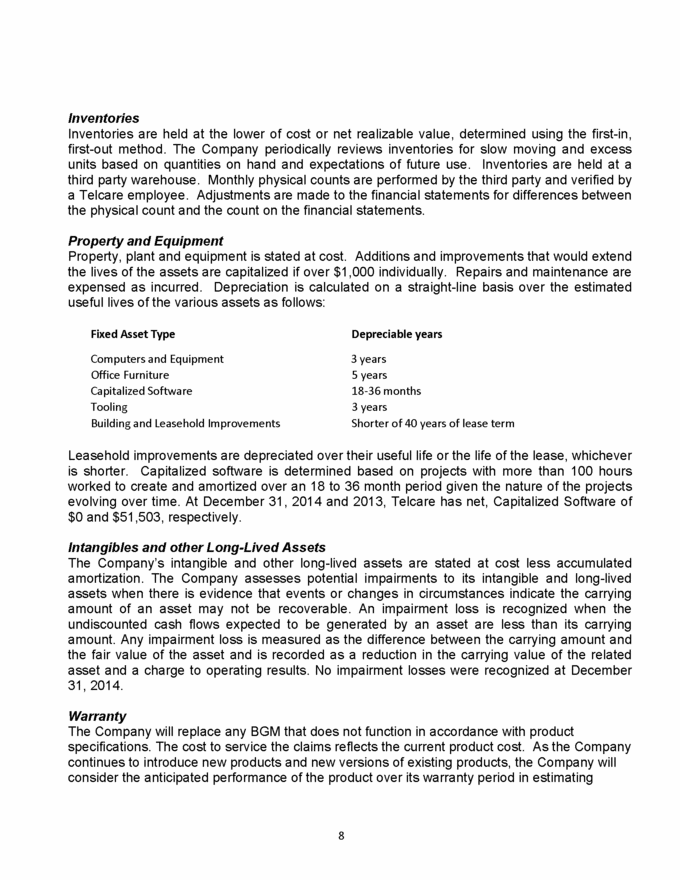
warranty reserves. These estimates are based on historical experience. The Company incurred minimal warranty costs as of December 31, 2014. The warranty reserve required as of December 31, 2014 has been estimated to be insignificant. Revenue Recognition The Company generates its revenue from sales of its BGM and other diabetes related products, including blood glucose testing supplies, to customers and third-party distributors who resell the products to patients with diabetes. Revenue recognition requires that persuasive evidence of a sales arrangement exists, delivery of goods occurs through transfer of title and risk and rewards of ownership, the selling price is fixed or determinable and collectability is reasonably assured. With respect to these criteria: The evidence of an arrangement generally consists of a prescription or counter-signed agreement with a third party. Transfer of title and risk and rewards of ownership are passed to the third-party distributor, third-party payor or patient upon shipment of the products. The selling prices for all sales are fixed and agreed with the third-party distributor, third party payor or patient prior to shipment. The selling prices are based on established list prices or, in the case of certain third party distributors, contractually agreed upon prices. Provisions for discounts and rebates to customers are established as a reduction to revenue in the same period the related sales are recorded. For arrangements that do not include elements of software or software that is essential to delivered products, the Company allocates revenue to all deliverables based on a hierarchy, where Vendor Specific Objective Evidence of fair value is at the highest level; third-party evidence of selling price is second; and best estimate of the selling price is third. Best estimate of selling price reflects the Company’s estimates of what the selling prices of elements would be if they were sold regularly on a stand-alone basis. Shipping and Handling The Company does not always charge its customers for the costs associated with the shipping and handling of its product. The costs of shipping are included in Cost of Goods Sold. Concentration of Credit Risk Financial instruments that subject the Company to credit risk consist primarily of cash and cash equivalents and the Company’s cash is held at two accredited U.S. commercial banks. Research and Development Costs All costs of research and development (R&D) are expensed as incurred. R&D costs generally consist of non-recurring engineering costs for prototypes and other related testing and consulting costs associated with new products. General and Administrative Expenses General and administrative expenses are primarily comprised of salaries and benefits associated with executive, finance, legal and other administrative personnel, overhead and occupancy costs, outside legal costs, insurance costs and miscellaneous costs. 9
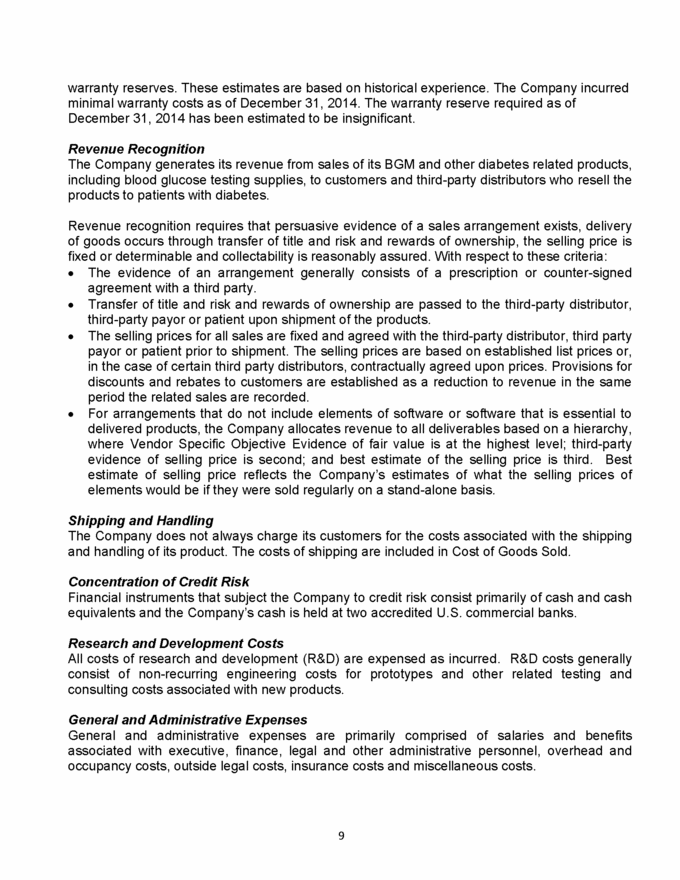
Sales and Marketing Expenses Sales and marketing expenses are primarily comprised of salaries and benefits associated with sales and marketing personnel, outside marketing expenses including commercial product samples, tradeshows and advertising expenses. Income Taxes The Company accounts for income taxes under the asset and liability method. Deferred tax assets and liabilities are recognized based on the differences between the financial statements carrying amounts and the tax bases of assets and liabilities. Income taxes are provided for using enacted statutory rates. Valuation allowances are provided for deferred tax assets if it is determined that it is more likely than not that some or all of the deferred tax assets will not be realized. In evaluating the ability to realize net deferred tax assets, all available evidence is considered, both positive and negative, including past operating results, tax planning strategies and forecasts of future taxable income. Management periodically performs a comprehensive review of the tax positions and accrues amounts for tax contingencies. The Company follows the guidance on accounting for uncertainty in income taxes, which addresses the determination of whether tax benefits claimed or expected to be claimed on a tax return should be recorded in the financial statements. Under this guidance, the Company may recognize the tax benefit from an uncertain tax position only if it is more likely than not that the tax position is sustainable, based solely on its technical merits and consideration of the relevant taxing authorities widely understood administrative practices and precedents. The tax benefits recognized in the financial statements from such a position are measured based on the largest benefit that has a greater than fifty percent likelihood of being realized upon ultimate settlement. The guidance on accounting for uncertainty in income taxes also addresses de-recognition, classification, interest and penalties on income taxes, and interim period accounting. The Company’s policy is to account for interest and penalties as a component of income tax expense. With few exceptions, the Company is no longer subject to income tax examinations by the U.S. federal, state or local income tax authorities for years before 2011. Share-Based Compensation The Company accounts for stock-based compensation under the provisions of FASB ASC 718-10, Compensation-Stock Compensation (ASC 718-10), which requires that measurements and recognition of expense for all share-based compensation of employees and directors be based on estimated fair values of the share-based awards. Accordingly, compensation costs for all share-based awards to employees are measured based on the grant date fair value of those awards and recognized over the period during which the employee is required to perform services in exchange for the award (generally over the vesting period of the award). The Company estimates the fair value of share-based payment awards issued in the form of options using the Black-Scholes-Merton option pricing model. To date, the Company has not granted awards with market or performance conditions. 10

Share-based compensation expense results from estimating the fair value of each employee award granted. Given the absence of an active market for the Company’s common stock, the fair value of the award on the date of grant was determined by management using several factors, including an independent valuation. For all employee share-based payment awards issued in the form of options, compensation expense is amortized under the straight-line attribution method. Compensation expense recognized in the statement of operations is based on awards ultimately expected to vest, and it has been reduced for estimated forfeitures. Share-based compensation expense guidance requires forfeitures to be estimated at the time of grant and revised, if necessary, in subsequent periods if actual forfeitures differ from those estimates. Share-based payment awards issued in the form of restricted stock are measured at their fair value on the grant date. Compensation expense is recognized in the statement of operations over the vesting period of the awards. For the years ended December 31, 2014 and 2013 the Company recorded $154,869 and $118,301 of stock-based compensation expense, respectively. See Footnote 6 for a summary of the stock option activity under the Company’s stock based employee compensation plan. Comprehensive Loss The Company does not have any items of comprehensive loss other than net loss for the years ended December 31, 2014 or December 31, 2013. New Accounting Standards In 2011 and 2013 the FASB issued new accounting guidelines related to disclosures on offsetting assets and liabilities on the balance sheet. These new guidelines require the Company to disclose both gross and net information about transactions eligible for offset on the balance sheet. These guidelines are to be applied retrospectively starting with the first quarter of 2014. Applications of these guidelines did not have a material impact on the Company’s financial statements. In 2012 the FASB updated guidelines related to indefinite-lived intangible asset impairment testing. These updated guidelines allow entities to first assess qualitative factors before performing a quantitative assessment of the fair value of indefinite-lived intangible assets. Qualitative factors include related events and circumstances that could affect the significant inputs used in determining fair value of the indefinite-lived intangible assets. The adoption of these updated guidelines had no material impact on the Company’s financial statements. In July 2013, the Financial Accounting Standards Board (“FASB”) issued guidance for the presentation of an unrecognized tax benefit when a net operating loss ("NOL") carryforward, a similar tax loss, or a tax credit carryforward exists. The guidance requires an entity to present in the financial statements an unrecognized tax benefit, or a portion of an unrecognized tax benefit, as a reduction to a deferred tax asset for an NOL carryforward, a similar tax loss, or a tax credit carryforward. If the NOL carryforward, a similar tax loss, or a tax credit carryforward is not available at the reporting date under the tax law of the jurisdiction or the tax law of the 11
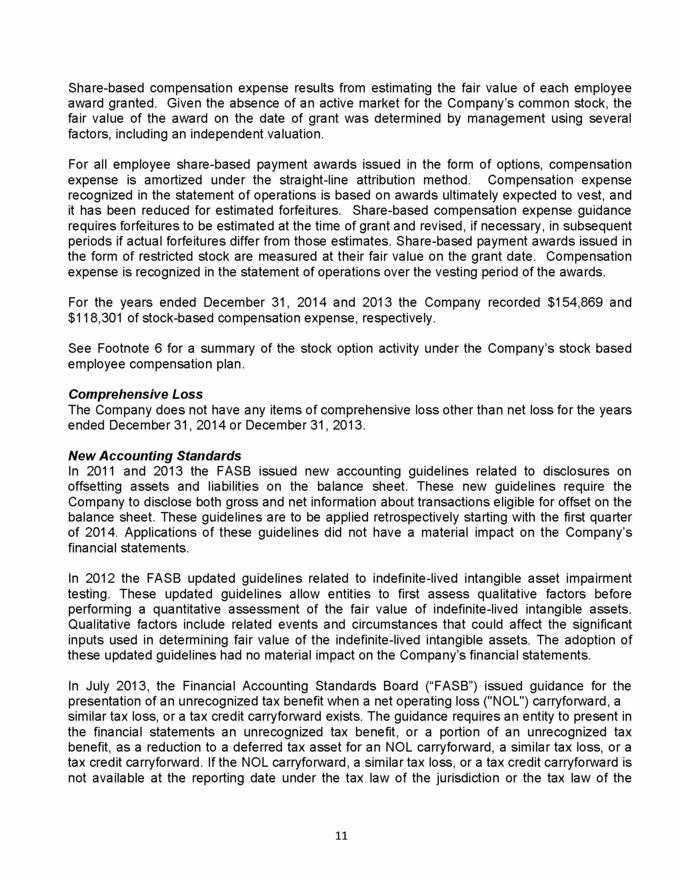
jurisdiction does not require the entity to use, and the entity does not intend to use, the deferred tax asset for such purpose, the unrecognized tax benefit will be presented in the financial statements as a liability and will not be combined with deferred tax assets. This guidance does not require any additional recurring disclosures and is effective for fiscal years beginning after December 15, 2013. The adoption of this guidance did not have a material impact on the financial statements. In May 2014, the FASB issued guidance for revenue recognition for contracts, superseding the previous revenue recognition requirements, along with most existing industry-specific guidance. The guidance requires an entity to review contracts in five steps: 1) identify the contract, 2) identify performance obligations, 3) determine the transaction price, 4) allocate the transaction price, and 5) recognize revenue. The new standard will result in enhanced disclosures regarding the nature, amount, timing and uncertainty of revenue arising from contracts with customers. The standard is effective for the reporting year beginning January 1, 2018 and early adoption is permitted in certain circumstances. The Company is currently evaluating the impact, if any, that this new accounting pronouncement will have on its financial statements. In August 2014, the FASB issued guidance requiring management to evaluate on a regular basis whether any conditions or events have arisen that could raise substantial doubt about the entity’s ability to continue as a going concern. The guidance 1) provides a definition for the term “substantial doubt,” 2) requires an evaluation every reporting period, interim periods included, 3) provides principles for considering the mitigating effect of management’s plans to alleviate the substantial doubt, 4) requires certain disclosures if the substantial doubt is alleviated as a result of management’s plans, 5) requires an express statement, as well as other disclosures, if the substantial doubt is not alleviated, and 6) requires an assessment period of one year from the date the financial statements are issued. The standard is effective for the reporting year beginning January 1, 2017 and early adoption is permitted. The Company does not expect the adoption of this guidance to have a material impact on its financial statements. The Company has evaluated all other issued and unadopted Accounting Standards Updates and believes the adoption of these standards will not have a material impact on the results of operations, financial position, or cash flows. 4. Financial Statement Details Restricted Cash In October 2014, Telcare entered into an agreement with a customer to provide to the customer’s patients a diabetes management program utilizing Telcare’s BGM, supplies and patient portal. The agreement stated that the customer would reimburse Telcare for the cost of each BGM unit shipped each month after a list of patients receiving the unit had been submitted, reviewed and approved by the customer. To facilitate this arrangement, the customer deposited $2 million into a separate Telcare bank account, to be used only for the reimbursement of approved shipments of the BGM unit and not to be comingled with other Telcare operating bank accounts. In the first quarter of 2015 the program was terminated. A total payment of $96,200 for BGM’s shipped and accepted was made and the remaining amount of $1,903,800 was returned to the customer in May 2015. 12
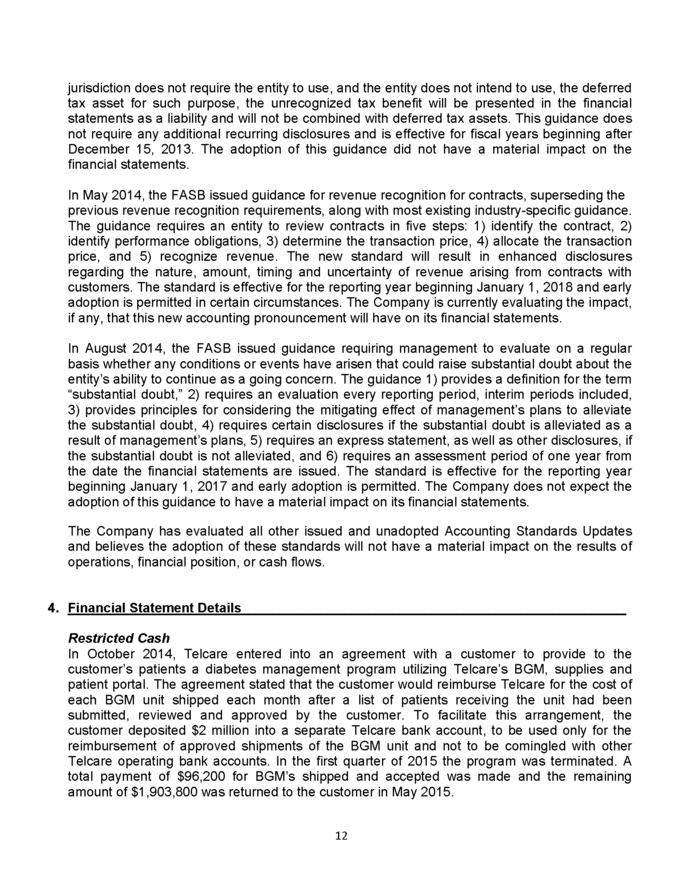
Accounts Receivable Accounts receivable as of December 31, 2014 and 2013 was $565,345 and $1,737,681, respectively. All balances are net of write-offs and adjustments that occur on a monthly basis. One customer accounted for $2.8 million and $4 million of the gross Accounts Receivable balance as of December 31, 2014 and 2013, respectively. The Company collected $1.2 million of this balance in 2014. Based on discussions with the customer and after an analysis of the collectability of the remaining $2.8 million receivable, the Company recorded an allowance of $2.5 million against this balance. An arrangement was made for the payment of the remaining $300,000 in 2015. Based on discussions with the customer and after an analysis of the collectability of the remaining $300,000 receivable, the Company recorded a full allowance against the remainder for a total reserve of $2.8 million against this customer balance. Allowance for doubtful accounts was $2.9 million and $2.5 million as of December 31, 2014 and 2013, respectively. Inventory Inventories are stated at the lower of cost or net realizable value, with cost determined on a first-in, first-out basis. Inventory balances, net of reserves, at December 31, 2014 and 2013 are as follows: 2014 2013 Starter Kits Test Strips Prepaid Starter Kit parts Other Inventory $ 1,303,900 71,103 - 47,776 $ 1,356,651 396,272 832,609 246,993 Net Inventory $ 1,422,779 $ 2,832,525 The Company had a total provision for inventory reserves at December 31, 2014 and 2013 of $3,640,008 and $2,862,749, respectively. In 2014, the Company established a $2.2 million provision for excess and slow moving inventory against the Version 1.5 BGMs. Added to the $1.1 million reserve for Version 1.0 BGMs established in 2013 brings the total reserve for excess and slow moving inventory to $3.3 million at December 31, 2014. The Company wrote off the inventory associated with the reserve established in 2013 of $1.2 million for test strips and $100,000 for control solution and reduced the reserve accordingly. The remainder of the provision is to reduce the carrying value of the BGMs to the lower of cost or net realizable value at year end. 13

Property, Plant and Equipment Property, plant and equipment balances are as follows as of December 31: 2014 2013 Furniture, Fixtures and Equipment Capitalized Software Tooling Leasehold Improvements Total Less: Accumulated Depreciation and Amortization Net Propery, Plant and Equipment $ 206,257 133,360 - - $ 171,075 133,361 99,437 4,079 $ 339,617 407,952 (220,184) (203,288) $ 119,433 $ 204,664 Depreciation and amortization expense respectively. was $123,606 and $111,390 in 2014 and 2013 Investments During 2013, Telcare, Inc. invested $100,000 in a company called Common Sensing for a 7% ownership stake. This is considered a minority interest in this company and is classified as an available-for-sale investment on the balance sheet, and is included in Other Assets. The Company classifies it as available-for-sale due to the nature of the stock purchased. Common Sensing is a private company with no open market for their stock. Telcare intends on holding the stock in the near term as Telcare continues a business partnership with Common Sensing. There is no maturity date listed on the security. The carrying value approximates fair value as of December 31, 2014 and 2013. Other Assets At December 31, 2014 and 2013, Telcare has Other Assets of $249,653 and $302,864, respectively. Included in these amounts are Investments as noted above. Deferred Rent Deferred rent related to two office leases in Bethesda, MD and Concord, MA. Deferred rent is based on the total cash payment expense for each month compared to a calculated straight-line rent. The straight-line rent is calculated based on the total payments over the life of the leases by the amount of rent required in an escalating rent schedule year-over-year on the lease. 14
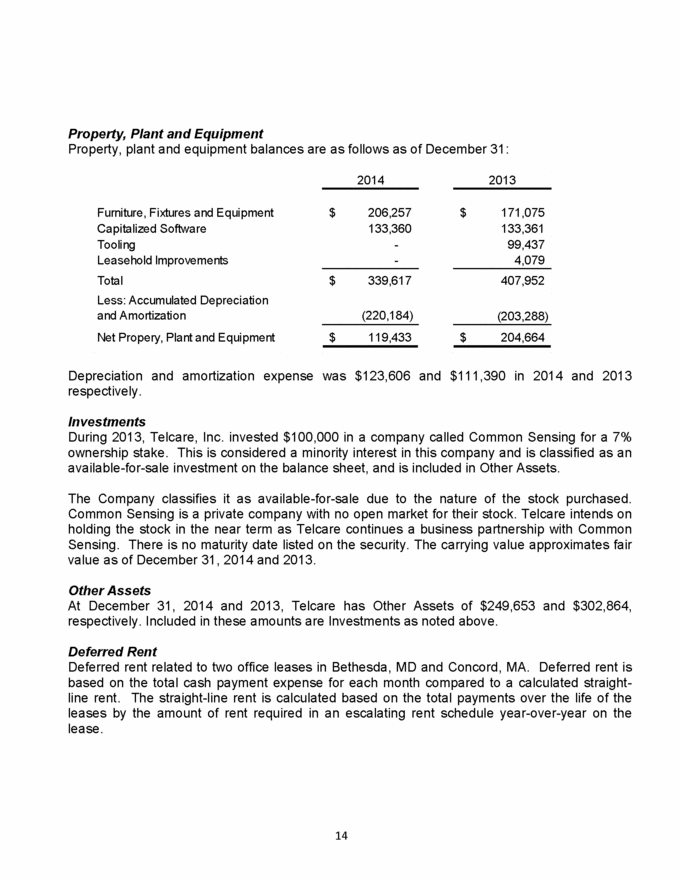
Accounts Payable and Accrued Liabilities Accounts Payable and Accrued Liabilities at December 31, consist of the following: 2014 2013 Accounts Payable Accrued Liabilities Deferred Rent $ 2,014,304 627,456 54,820 $ 1,617,444 205,948 32,346 Total $ 2,696,580 $ 1,855,738 Customer Deposit Payable In October 2014, Telcare entered into an agreement with a customer to provide to the Customer’s patients a diabetes management program utilizing Telcare’s BGM, supplies and patient portal. To facilitate this arrangement, the customer deposited $2 million interest free into a separate Telcare bank account, to be used only for the reimbursement of approved shipments of the BGM unit. Unused funds were to be returned to the customer upon termination of the program, which occurred in the first quarter of 2015. A total payment of $96,200 for BGM’s shipped and accepted was made and the remaining amount of $1,903,800 was returned to the customer in May 2015. Long-Term Debt Silicon Valley Bank Note On February 27, 2013, the Company entered into a long term note agreement with Silicon Valley Bank in the principal amount of $5,000,000, at an annual interest rate of 1.5% above the then current Prime Rate (3.25% as of December 31, 2013). Starting on January 1, 2014, the principal is payable in 36 equal monthly installments plus any accrued interest. The loan is collateralized by an interest in the Company’s current Accounts Receivable and Inventory. Interest at 1.5% above the current Prime Rate (3.25%) was charged and paid monthly during 2013, prior to the beginning of principal repayment. There was a $35,000 commitment fee paid to Silicon Valley Bank and this amount was charged to administrative expense in 2013. Additionally, 33,333 warrants to purchase Series B Preferred stock at an exercise price of $3.00 per share were issued to Silicon Valley Bank in connection with the Loan commitment. The grant date value at February 28, 2013 of the warrant issued to Silicon Valley Bank, using the Black-Scholes valuation method, was calculated to be $70,297. The value of the warrants is analyzed at the end of each year and adjusted at that time, if appropriate, to the fair market value. At December 31, 2014 and 2013 the value of this warrant was $65,147 and $67,738, respectively. Based on the anti-dilution provision of Series B Preferred Stock, on October 3, 2014 Silicon Valley Bank received, as part of the Series C Preferred financing, 10,729 additional warrants to 15
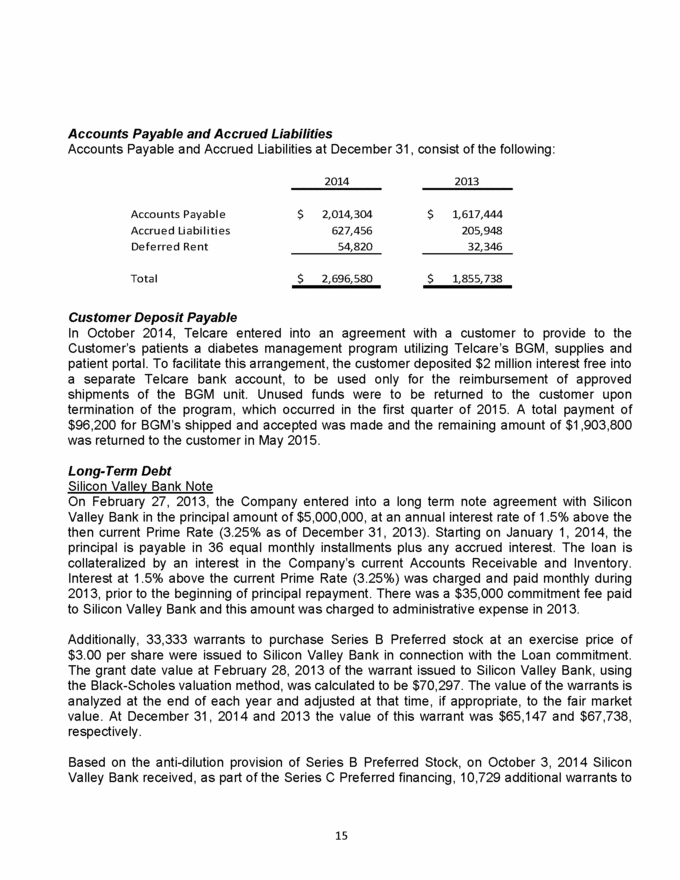
purchase Series B Preferred stock at an exercise price of $1.57 per share. The value at the grant date using the Black-Scholes valuation method was calculated to be $11,845. The fair market value of these warrants at December 31, 2014 was $11,770. The warrants are accounted for as a liability on the balance sheet. A gain related to the change in fair value of the warrants of $2,666 and $2,551 was recognized in the statement of operations for the years ended December 31, 2014 and 2013, respectively. Promissory Notes In December 2013, the Company offered $5,000,000 of unsecured Promissory Notes to certain current shareholders. A total of $3,750,000 of these promissory notes were issued in December 2013, $1,000,000 in January 2014 and the remainder in the third quarter of 2014. In 2014, the Company offered an additional $2,500,000 in unsecured Promissory Notes to certain current shareholders. As of September 2014 all of these promissory notes were issued. In October 2014, all $7,500,000 of the Promissory Notes and accrued interest of $205,103 were converted into 4,921,027 shares of the Company’s Series C Convertible Preferred stock. State of Maryland Grant On May 24, 2011 the Company signed a Biotechnology Commercialization Award Agreement with the Maryland Biotechnology Center, a unit of the State of Maryland’s Department of Business and Economic Development, and received a grant of $200,000. This grant was received in support of the Company’s application for funds for Telcare’s final commercialization of its Cellular Enabled BGM. These funds were to be used to help in the reengineering of the Company’s v2.0 product to include multiple enhancements utilizing the Company’s cellular capabilities. According to the terms of the agreement, the Company repaid these funds in the amount of $250,000 in January 2015. Development and Other Agreements Pursuant to a funding agreement dated February 17, 2012 between the Company and Cellco Partnership, d/b/a Verizon Wireless, the Company received a non-interest bearing loan from Verizon Wireless in the amount of $98,000 to facilitate the development of Telcare’s CDMA wireless BGM, version v1.5, the repayment of which was due September 1, 2014. Per the agreement, the loan is due 12 months from the Commercial Sales launch of the Company’s Version v1.5 BGM. For purposes of the funding agreement, the Commercial Sales launch is defined as 60 days after (i) the BGM receives Federal Drug Administration (FDA) clearance as contemplated by Section 6(b) of the funding agreement or (ii) the BGM receives open development certification by Verizon Wireless as defined by Section 6(a) of the Funding Agreement. The Verizon Open Development Certification was achieved June 12, 2013 and the FDA clearance was received July 1, 2013. The Company repaid this non-interest bearing note in full in November 2014. 16
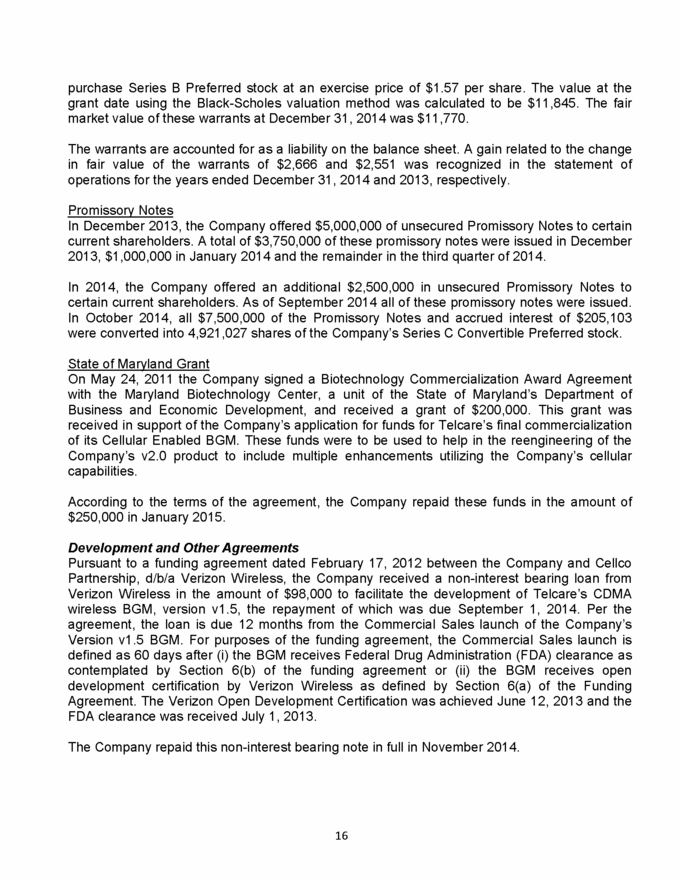
Warrant Liability On August 17, 2012, as part of the Series B Convertible Preferred Stock offering, the Company issued a warrant to a shareholder to purchase up to 325,000 additional shares of the Company’s Series B Convertible Preferred shares at an exercise price of $3.08 per share. In February 2013, the Company issued to Silicon Valley Bank a warrant to purchase up to 33,333 shares of the Company’s Series B Convertible Preferred shares at an exercise price of $3.00 per share. In October 2014, the Silicon Valley Bank received an additional warrant to purchase up to 10,729 shares of the Company’s Series B Convertible Preferred shares at an exercise price of $1.57 per share. Each of these warrants has a term of 10 years from the date of issuance. At December 31, 2014, Series B Convertible Preferred Stock included a mandatory redemption feature which states that the Series B Preferred shares were mandatorily redeemable six years after issuance. The Company determined if the warrants issued should be classified as a liability or as equity, as these warrants were issued in connection with an equity transaction. Under ASC 480, Distinguishing Liabilities from Equity, if the underlying equity instrument to be issued upon the exercise of the warrant carries an unconditional obligation requiring the issuer to redeem the instrument by transferring assets at a specified or determinable date, then the instrument is considered a liability. Warrants for a mandatorily redeemable preferred share are considered a liability. Using the Black-Scholes valuation method, the grant date fair value of the warrants at August 17, 2012 was $700,549. The value of the warrants is analyzed at the end of each year and adjusted at that time, if appropriate, to the fair market value. At December 31, 2014 and 2013 the fair value of these warrants was $592,627 and $639,565, respectively. As a result of a reduction in the fair value of the warrants, a gain of $46,938 and $37,621 was recognized in the statement of operations for the year ended December 31, 2014 and 2013, respectively. The value at February 28, 2013 of the warrant issued to Silicon Valley Bank, using the Black-Scholes valuation method, was calculated to be $70,297. The value of the warrants is analyzed at the end of each year and adjusted at that time, if appropriate, to the fair market value. At December 31, 2014 and 2013 the value of this warrant was $65,746 and $67,738. As a result of a reduction in the fair value of the warrants, a gain of $1,992 and $2,559 was recognized in the statement of operations for the years ended December 31, 2014 and 2013, respectively. The value at October 3, 2014 of the additional warrant issued to Silicon Valley Bank, using the Black-Scholes valuation method, was calculated to be $11,845. The value of the warrants is analyzed at the end of each year and adjusted at that time, if appropriate, to the fair market value. At December 31, 2014 the value of this warrant was $11,771. As a result of a reduction 17

in the fair value of the warrants, a gain of $74 was recognized in the statement of operations for the year ended December 31, 2014. The change in fair market value of the warrant liability was recorded as Other Income in the year of the adjustment. For the years ended December 31, 2014 and 2013, this gain was $49,580 and $40,180, respectively. Convertible Preferred Stock In August 2012, the Company offered its Series B Convertible Preferred shares to the holders of its promissory notes that were issued and unpaid at that time. Applicable accrued interest was paid in cash. A total of 1,847,082 Series B Preferred Shares were converted as part of this program at a price of $2.40 per share. The Series B Preferred shares offered in the exchange transaction had a fair value of $3.00 per share. The Company executed the above unsecured convertible promissory notes for $4.4 million in September 2011 with a number of individual investors. The convertible promissory notes accrued interest at 8% per year. Principal and accrued interest was convertible or due at the earlier of the maturity date, defined as twelve months from the date of the note, or a qualified financing event, into Series B Preferred Stock or equity equivalent. Upon a qualifying event, as defined by the agreement, the principal is converted into Series B Preferred Stock, at a conversion discount of 20%. As a result of the amortization of the value of the beneficial conversion feature included in the promissory notes and the subsequent extinguishment of the debt, the Company recorded charges to operations and increased the Series B Preferred Stock balance in the amount of $1,108,249 through December 31, 2012. At the same time, the Company offered for sale its Series B Convertible Preferred Stock, Par Value $0.001, to outside investors at a sales price of $3.00 per share. A total of 6,833,332 shares were sold at this price. The Company also agreed to repurchase 71,811 shares of the Series B Convertible Preferred shares issued as part of the conversion of promissory notes at a purchase price of $3.00 per share. At December 31, 2014 and 2013 there were 8,775,270 shares of Series B Convertible Preferred Shares issued and outstanding. At December 31, 2013, Series B Convertible Preferred Stock included a redemption feature which states that the Series B Convertible Preferred shares were mandatorily redeemable six years after issuance. As of December 31, 2014 there is a Redemption date, February 17, 2019, by which time the Series B Convertible Preferred shares became mandatorily redeemable. The Company assessed whether Series B Convertible Preferred Stock be classified as a liability or as permanent equity. Under ASC 480, Distinguishing Liabilities from Equity, if the 18

conversion of the equity instrument requires the issuer to redeem the instrument by transferring assets at a specified or determinable date, then the instrument is considered a liability. Using ASC 480-10, it was determined that as the stock is redeemable at the option of the holder (See Mandatory Redemption) below that the Series B Convertible Preferred shares included features of a liability and equity and were therefore classified between Liabilities and Equity on the Balance Sheet. In October 2014, the Company offered its Series C Convertible Preferred shares to the holders of its promissory notes that were issued and unpaid at that time, including accrued and unpaid interest. A total of 4,920,870 Series C Convertible Preferred Shares were converted as part of this program at a price of $1.57 per share. The convertible promissory notes accrued interest at 8% per year. Principal and accrued interest was convertible or due at the earlier of the maturity date, defined as twelve months from the date of the note, or a qualified financing event, into Series C Convertible Preferred Stock or equity equivalent. At the same time, the Company offered for sale its Series C Convertible Preferred Stock, Par Value $0.001, to certain existing shareholders as well as outside investors at a sales price of $1.57 per share. A total of 17,243,578 shares were sold at this price, for $26,753,142 in proceeds net of offering costs. At December 31, 2014, there were 22,164,448 shares of Series C Convertible Preferred Shares issued and outstanding. As of December 31, 2014, there is a redemption date, February 17, 2019, by which time the Series C Convertible Preferred shares become mandatorily redeemable. The Company assessed whether Series C Convertible Preferred Stock be classified as a liability or as permanent equity. Under ASC 480, Distinguishing Liabilities from Equity, if the conversion of the equity instrument requires the issuer to redeem the instrument by transferring assets at a specified or determinable date, then the instrument is considered a liability. Using ASC 480-10, it was determined that as the stock is redeemable at the option of the holder (See Mandatory Redemption) below that the Series C Convertible Preferred shares included features of a liability and equity and were therefore classified between Liabilities and Equity on the Balance Sheet. Conversion Each share of Series A, Series B and Series C Convertible Preferred Stock is convertible into common stock at the option of the holder at the original issuance price, subject to an adjustment for a stock split, stock dividend or other similar recapitalization, plus an amount equal to all declared but unpaid dividends. Mandatory Redemption At or before February 17, 2019 (Redemption Date), the Company, upon the written election of at least 60% of the then outstanding shares of Series B and Series C Convertible Preferred Stock, voting together as a single class, to the extent the Corporation may lawfully and without 19
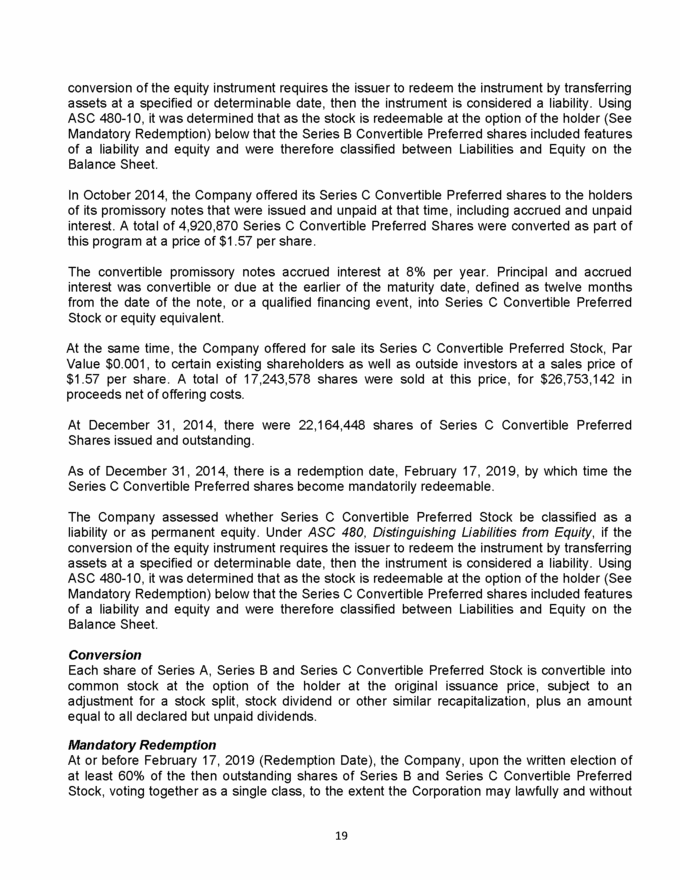
violating any contractual agreements do so, may require the Corporation to redeem all of the then outstanding shares of Series B and Series C Convertible Preferred Stock. The redemption price for each share of Series B and Series C Convertible Preferred Stock will be the original issue price subject to an adjustment for a stock split, stock dividend or other similar recapitalization, plus an amount equal to all declared or accrued but unpaid dividends or the fair market value of a single share of Series B and Series C Convertible Preferred Stock as of the Redemption Date. 5. Commitments and Contingencies Operating Lease The Company leased approximately 7,000 square feet of office space in an office building in Bethesda, MD under a lease that expired September 30, 2014. The Company secured new office space in an office building in Bethesda, MD in August 2014 and occupied that space as of September 1, 2014. This new lease is for 42 months and included two and a half months rent abatement. The Company also leased approximately 7,500 square feet of office space in an office building located in Concord, MA under a lease that expired November 30, 2014. The Company renewed its lease on the Concord, MA office space and secured an additional 3,500 sq. ft. of space connected to the current space. This amended lease is for a period of three years. Future minimum lease payments for each of the next three years under these operating leases are: 2015 2016 2017 Total Total $449,796 $ 467,135 $ 471,291 $ 1,388,222 Office rent expense was approximately $366,469 in 2014 and $283,190 in 2013. The Company has not entered into any capital leases. Debt The following are the scheduled maturities of the Silicon Valley Bank notes as of December 31, 2014: 2015 2016 Total Total $ 1,666,667 $ 1,666,667 $ 3,333,335 Interest expense, including amortization of discount and deferred charges, was $197,312 for the year ended December 31, 2014. 20

License Obligations In 2014, the Company entered into a three year license of a third-party database platform. The future license payments will be as follows: 2015 2016 2017 Total Total $ 152,892 $ 157,097 $ 143,305 $453,294 Litigation The Company received notice in the fourth quarter of 2013 alleging Telcare had infringed upon a patent for certain parts of its BGM. Telcare contested this allegation. In the first quarter of 2014, Telcare entered into a license agreement with the patent holder for use of its patented technology in the Company’s BGM. Telcare expensed and accrued $150,000 in 2013 for this license fee and payment was made in 2014. Telcare was not a party to any legal actions as of December 31, 2014 or December 31, 2013. 6. Equity Common Stock The Company was formed in 2009 with the issuance of 8,000,000 shares of Common Stock, par value $0.001 per share, to three individuals, on an equal basis, for services rendered for the formation and start of the Company. The Company recorded the value of these shares at par value of $0.001 per share or $8,000. In August 2012, the holders of the Company’s Series A Convertible Preferred shares were issued 227,970 shares of Common Stock in payment of accrued dividends and for the termination of dividends on the Series A Convertible Preferred shares. Common Stock was issued at a ratio of 0.511143 shares of Common Stock per share of Series A Convertible Preferred Stock (the “Dividend”). In August 2012, as part of the Series B Convertible Preferred stock offering, the Company agreed to repurchase 962,146 common shares through the issuance of Series B Preferred shares at the then fair market value of $3.00 per share. In April 2014 the Company selected a new Chairman of the Board and issued 470,984 shares of restricted Common Stock of the Company representing, at that time, 2.25% of the Company’s issued and outstanding shares at the fair market value price of $0.66 per share, representing a total of $310,849. 25% of these restricted shares vested immediately and the remaining will vest over twelve months, starting on June 1, 2014. The Company will expense the cost of these restricted shares according to their vesting schedule. The restricted shares have an anti-dilution feature which gives the shareholder the right to receive additional shares of the Company’s stock in any new offering made within one year to maintain the ownership percentage of 2.25%. In October 2014, as part of the Company’s Series C Preferred Stock 21

issuance, 721,712 additional shares of the Company’s restricted common stock with a value of $476,345 were issued under this anti-dilution feature. A total of $349,808 was expensed as share-based compensation in 2014 and included as General and Administrative costs. Unrecognized compensation cost related to stock issuances under ASC 718 at December 31, 2014 was $437,371, and will be recognized through May 1, 2015. As of December 31, 2014 and 2013 the Company had 8,458,520 and 7,265,824 shares of Common Stock issued and outstanding. Preferred Stock In 2010 the Company sold for $1.00 per share, 4,460,000 shares of Series A Convertible Preferred stock, $0.001 par value, with a dividend of 7.5% per annum, convertible into one share of Common Stock for each share of Series A Convertible Preferred Stock held. In August 2012, as part of the Series B Convertible Preferred Stock offering, the Company agreed to repurchase 632,710 shares of issued and outstanding Series A Convertible Preferred shares at the then fair market value of $3.00 per share. Dividends on Series A Convertible Preferred Stock accrued until August 2012 at which time, as part of the Series B Convertible Preferred Stock offering, all accrued Series A Convertible Preferred dividends were converted into 227,970 shares of the Company’s Common Stock. Additionally, on December 20, 2010, the Company issued to a shareholder a warrant to purchase up to 200,000 shares of the Series A Convertible Preferred Stock over a seven year period at an exercise price of $1.00 per share. The Company determined if the warrants issued should be classified as a liability or as equity, as these warrants were issued in connection with an equity transaction. Under ASC 480, Distinguishing Liabilities from Equity, if the underlying equity instrument to be issued upon the exercise of the warrant carries an unconditional obligation requiring the issuer to redeem the instrument by transferring assets at a specified or determinable date, is mandatorily redeemable or provides an obligation to issue a variable number of shares, then the instrument is considered a liability. Management determined that the warrant issued with the Series A Preferred stock did not include any of these features and the warrants are accounted for as equity on the balance sheet. Using the Black-Scholes method of valuation, the grant date fair value of these warrants was determined to be $143,757. As of December 31, 2014 and 2013 the Company had 3,827,290 shares of Series A Convertible Preferred shares issued and outstanding. See Footnote 4 for a discussion of the Company’s Series B and Series C Convertible Preferred Shares. 22

Stock Option Plan As of December 31, 2014 and 2013, the Company had one equity incentive plan, the Telcare, Inc. 2011 Stock Option Plan (the Plan), under which incentive stock options, nonqualified stock options, restricted stock units, incentive stock and restricted stock awards can be granted to employees, directors and business partners. Options generally vest over a four year period from the date of the grant and expire no later than ten years from the vesting period commencement date, as determined by the Board of Directors. At December 31, 2014 there were 7,477,656 shares authorized for issuance. A summary of the activity under the Plan for 2014 and 2013 is as follows: Weighted-Average Remaining Contractual Life in Years Weighted-Average Exercise Price Aggregate Intrinsic Value Number of Shares Options Outstanding at December 31, 2013 347,000 $ 2.35 8.71 Granted Cancelled Options Outstanding at December 31, 2014 227,000 (131,000) $ $ 3.00 1.71 9.08 7.15 443,000 $ 2.87 8.51 $ - Options Vested at December 31, 2014 178,896 $ 2.69 7.81 The aggregate intrinsic value was calculated based on the difference between the estimated fair value of the Company’s Common Stock and the exercise price of the underlying options. The Company determines the fair value of stock options using the Black-Scholes valuation model. The exercise price is set at or above the fair value of the Company’s common stock on the date of the grant. The Company utilizes the “simplified method” to calculate the expected term for options issued to employees or directors of the Company. Due to lack of marketability of the Company’s common stock, the Company utilized comparable public companies’ volatility rates as a proxy of its expected volatility for purposes of the Black-Scholes model. The risk-free interest rate assumption is based upon observed U.S. government security interest rates with a term that is consistent with the term of the Company’s employee stock options. The Company does not pay a dividend, and is not expecting to pay a dividend in the foreseeable future. The standard requires the Company to recognize expense over the service period for options that are expected to vest and record adjustments to compensation expense at the end service period if actual forfeitures differ from original estimates. The Company used historical data to estimate forfeiture rates for 2014 forfeitures were determined to be immaterial. 23
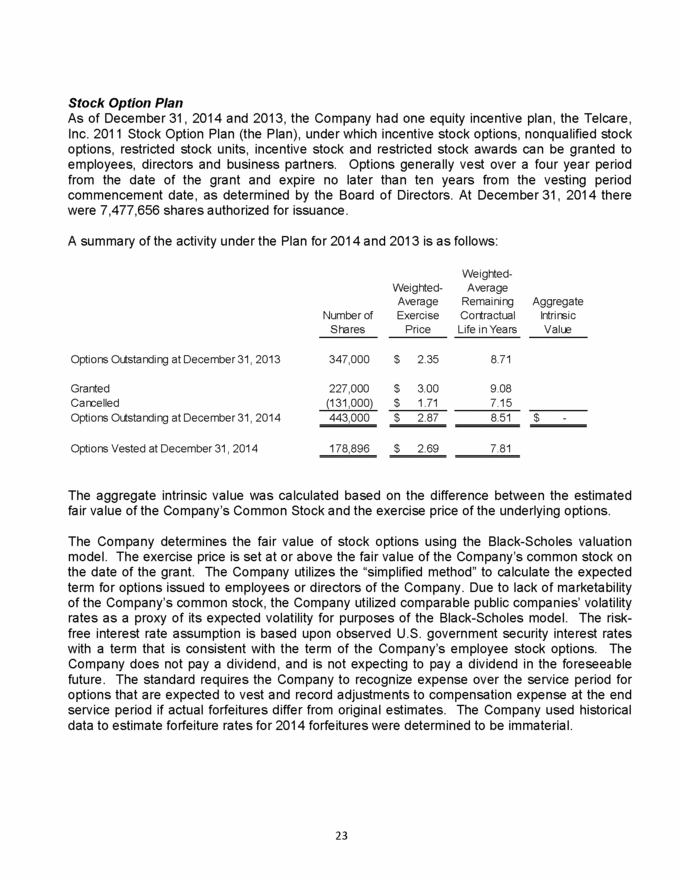
The following weighted average assumptions were used to estimate the fair value of stock options granted in 2014 using the Black-Scholes option pricing model: Risk free interest rate Expected dividend yield Expected term in years Expected volatilty 1.94% 0% 6.25 years 59% Stock based compensation expense related to stock options recognized was $154,868 and $118,302 for the year ended December 31, 2014 and 2013, respectively. Unrecognized compensation cost related to stock options under ASC 718-10 at December 31, 2014 and 2013 was approximately $462,387 and $361,376, respectively, and will be recognized over a weighted-average period of approximately nine years. 7. Income Taxes The Company paid no income taxes in 2014 or 2013 and recorded no current or deferred federal income tax expense or benefit for 2014 or 2013 with the Company being in a net operating loss position while maintaining a full valuation allowance. A valuation allowance is recorded on the net deferred tax assets. Due to losses incurred, the Company has not otherwise recorded any provision benefits for the years ended December 31, 2014 and 2013. Therefore, the difference between the statutory federal tax rate and the effective tax rate is primarily related to changes in valuation allowance. The realization of the deferred tax asset depends upon the Company’s ability to generate sufficient future taxable income. The Company has historically incurred net operating losses and is unable to carryback those net operating losses to previous tax years. Management has evaluated the positive and negative evidence bearing upon its ability to realize the Company’s deferred tax assets. Management has determined that it is more likely than not that the Company will not recognize the benefits of its federal and state deferred tax assets and, as a result, a full valuation allowance has been established as of December 31, 2014 and 2013. The Company’s remaining federal and state net operating losses will expire during various years through 2034, and some of them could be subject to annual limitations under the Internal Revenue Code Section 382 and similar state provisions. The Company recognizes tax benefits of uncertain tax positions only when the position is more likely than not to be sustained based solely on its technical merits and consideration of the relevant taxing authorities widely understood administrative practices and precedents. The Company has analyzed its tax positions and has concluded that no liability for unrecognized tax benefits should be recorded related to uncertain tax positions taken on returns filed for open tax years or expected to be taken on its current tax returns. The Company is not aware of any tax 24
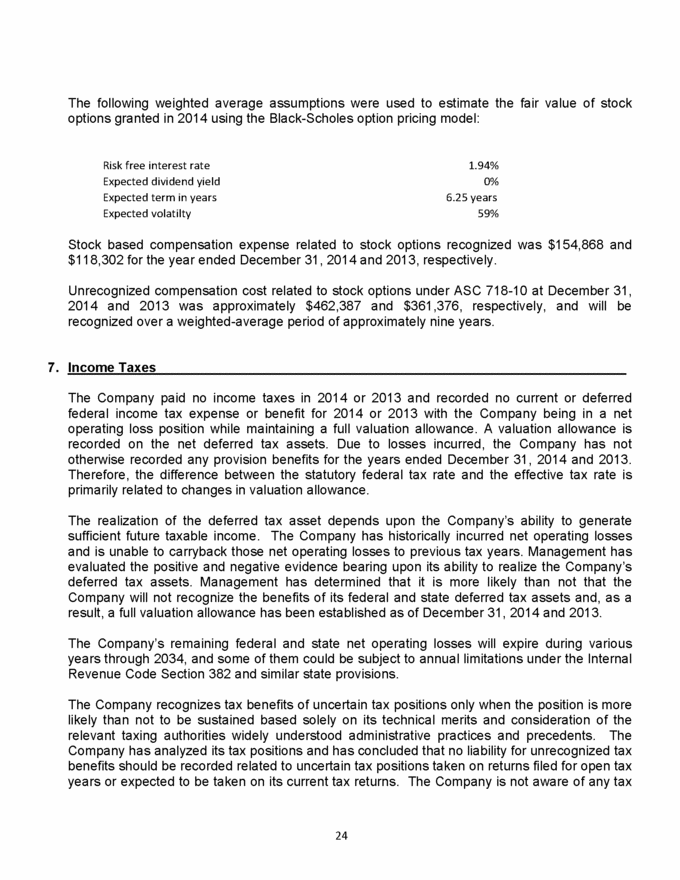
positions for which it is reasonably possible that the total of amounts of unrecognized tax benefits will change in the next twelve months. There are no current U.S. federal or state income tax examinations. 8. Subsequent Events With respect to the audited financial statements as of and for the year ended December 31, 2014, the Company has evaluated subsequent events through September 21, 2015, the date of the issuance of the financial statements. In May 2015, the Board of Directors granted the Chief Executive Officer of the Company a total of 2,650,456 stock options to purchase the Company’s Common Stock, equaling 5% of the issued and outstanding shares of the Company, at an exercise price of $0.66 per share representing the Company’s estimate of the fair market value of a Common Stock share on the grant date. Using the Black-Scholes option pricing model, the Company estimates the fair value of the option grant to be approximately $1.0 million which will be expensed over a four year vesting period. 25
